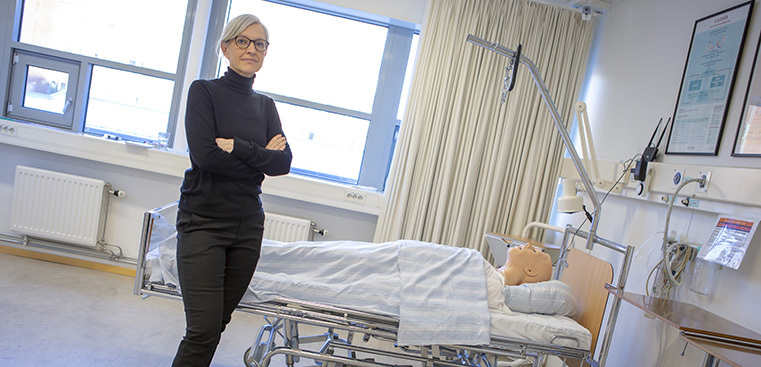New perspectives help children with home ventilators
2020-02-26

Today, new medicines and advanced treatment strategies mean that it is possible to survive diseases that were previously not survivable. Children with home ventilators live their lives at home with their families, often with the support of personal assistants. It is important to know how these families experience their situation in order to be able to develop health care practices and to support families in the best possible way.
Åsa Israelsson-Skogsberg recently defended her doctoral thesis within the research area the Human Perspective in Care at the University of Borås. In her thesis, she sought new knowledge about children living with home ventilators from four perspectives: the children themselves and their siblings, parents, and personal assistants.
A home ventilator is a relatively small device that can be connected to the child in different ways. This can be through a mask over the nose alone, over both the nose and the mouth, or through a tracheotomy, which is a surgical procedure in which an opening into the trachea is made in the throat, just below the larynx.
"Children with home ventilation are a very mixed group with varying care needs. It includes children who are entirely unable to breathe on their own and are completely dependent on their ventilator to breathe, as well as children who only need it at night when they sleep,” she explains.
The voice of the children must be heard
She met the children, siblings and also assistants at their home and conducted interviews. The data collection in relation to the parents took the form of a survey on health-related life quality, family functioning, and sleep habits.
"They opened up their homes to me, which was very special. It was important for me to point out that it was the children's own stories that were important; the child was the expert and the teacher in our meeting. We need more knowledge about families and children, and we must ensure that children's voices are heard," says Åsa Israelsson-Skogsberg.
Her thesis shows that children with home ventilators live their everyday lives with vigour and energy. An 11-year-old girl who could not breathe or swallow and barely had a voice said during her interview, "I'm not sick very often anymore."
"They see themselves as healthy. On the other hand, they have significant vulnerability to infections with a constant fight against pneumonia. When these children become ill, they may need to be hospitalised for longer periods, often in intensive care units. They also have a great vulnerability to other circumstances.”
Parents need more support
The study shows that 25 per cent of the parents' sleep estimates indicated insomnia. This can be compared to a Swedish population study from 2014 in which the corresponding figure for insomnia was 10.5 per cent.
In addition, parents estimated their health-related quality of life and family functioning as lower than previous research in which the same measuring instruments have been used with, for example, parents of children with type 1 diabetes.
"Parents of children with home ventilation are incredibly important in order to make everyday life work in this complex situation. This knowledge is therefore important for health care systems, as it can prompt breathing clinics to ask questions about how the parents are sleeping and how family life works and then provide support as needed,” says Åsa Israelsson-Skogsberg.
Worried siblings
Even siblings are greatly affected by living with a brother or sister who has a home ventilator. The study showed that they had developed characteristics of having great understanding of people who are different. At the same time, their lives have been marked by worry–worry about their parents' worries and also worries that their brother or sister would worsen.
The research also showed that personal assistants are extremely important to families. Being a personal assistant to someone with a home ventilator means great responsibility and challenging tasks, both technical and ethical, as well as having a work around unclear boundaries.
"I could see that they need more support from their employer as they often felt alone.”
She summarises her research by comparing everyday life to driving on a road. For most families, that path is rather straight and wide with the ability to steer away from obstacles and see far ahead.
"But for these families, the road is much narrower and they don’t have the same ability to compensate to adjust to changes. Therefore, external factors have a very large impact on their lives; for example, if personal assistance is withdrawn or if the electric wheelchair stops working. By knowing this, health care systems can be involved in making the road as stable and predictable as possible," concludes Åsa Israelsson-Skogsberg.
Read more
Link to the thesis (external link)
Link to Åsa's research profile
Text: Anna Kjellsson
Photo: Suss Wilén
Translation: Eva Medin

